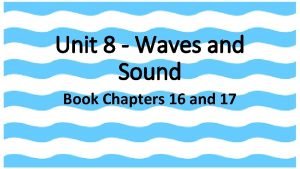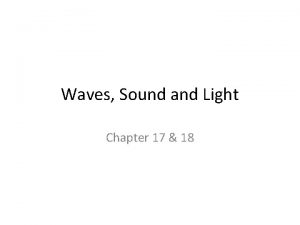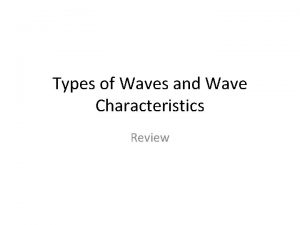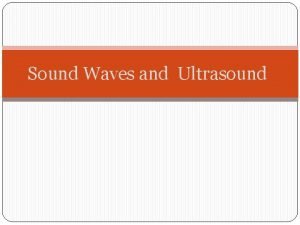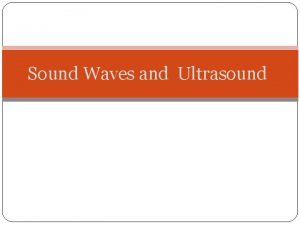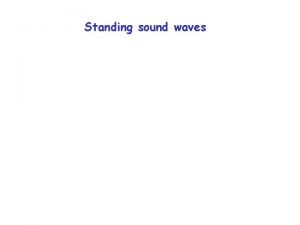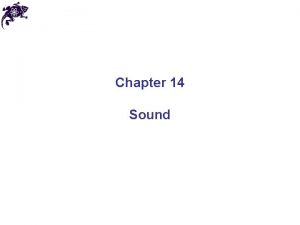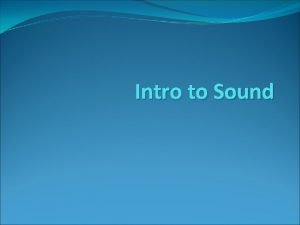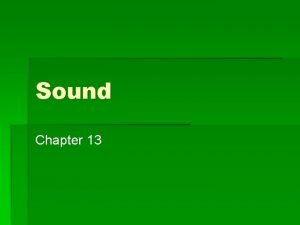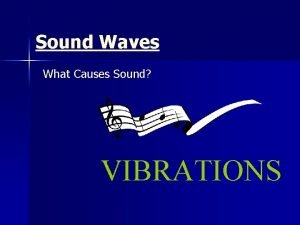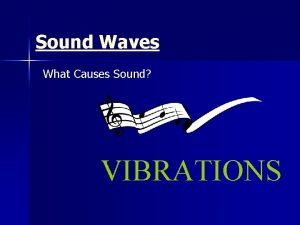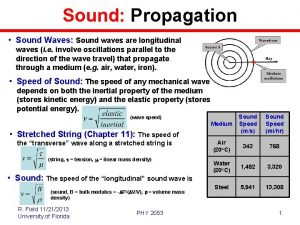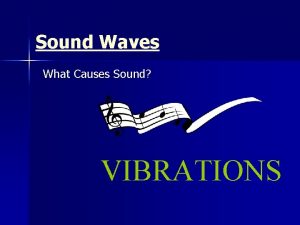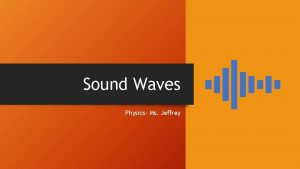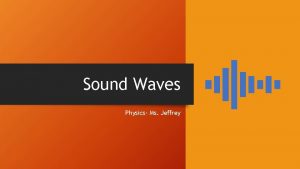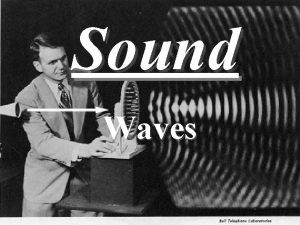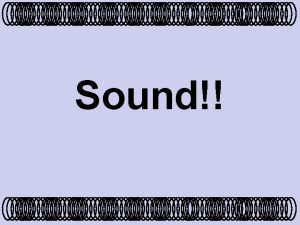Unit 2 Lesson 2 Interactions of Sound Waves




















- Slides: 20

Unit 2 Lesson 2 Interactions of Sound Waves Copyright © Houghton Mifflin Harcourt Publishing Company

Unit 2 Lesson 2 Interactions of Sound Waves Some Like It Hot What affects the speed of sound? • There are two main factors that affect the speed of sound: the type of medium the sound travels through, and the temperature of the medium. • If we know these factors, we can predict the speed of sound. Copyright © Houghton Mifflin Harcourt Publishing Company

Unit 2 Lesson 2 Interactions of Sound Waves What affects the speed of sound? • The speed of sound depends on the type of matter, or medium, through which sound travels. • The state of matter also affects sound waves. • Sound travels fastest through solids, slower through liquids, and slowest through gases. • The more packed together the particles are, the faster the wave will travel. Copyright © Houghton Mifflin Harcourt Publishing Company

Unit 2 Lesson 2 Interactions of Sound Waves What affects the speed of sound? • The speed of sound depends on the temperature of a medium. • Sound travels faster at higher temperatures than at lower ones. • Particles in a material move more quickly at higher temperatures and transfer energy faster. • Sound moves faster at higher temperatures and slower at cooler temperatures. Copyright © Houghton Mifflin Harcourt Publishing Company

Unit 2 Lesson 2 Interactions of Sound Waves Hello? How do sound and matter interact? • Sound waves do not travel easily through all matter. • Sound may bounce away from some surfaces. Sound may be absorbed by other sources or transmitted through a barrier • Reflection is the bouncing back of a wave when it hits a barrier. Sound waves reflect best off smooth, hard surfaces. Copyright © Houghton Mifflin Harcourt Publishing Company

Unit 2 Lesson 2 Interactions of Sound Waves How do sound and matter interact? • Some matter absorbs sound waves better than other matter. • A rough wall will absorb sound better than a smooth wall will. • Soft materials, such as rugs and drapes, will absorb sound better than hard surfaces will. Copyright © Houghton Mifflin Harcourt Publishing Company

Unit 2 Lesson 2 Interactions of Sound Waves How do sound and matter interact? • How will sound waves travel differently in each room? Copyright © Houghton Mifflin Harcourt Publishing Company

Unit 2 Lesson 2 Interactions of Sound Waves What is an echo? • An echo is a reflected sound wave. • The strength of the echo depends on the reflecting surface. • Echoes can be reduced using soft materials that absorb the sound waves. • Echoes can also be reduced using rough surfaces that scatter the sound waves. Copyright © Houghton Mifflin Harcourt Publishing Company

Unit 2 Lesson 2 Interactions of Sound Waves What is an echo? • Some animals—such as dolphins, bats, and beluga whales—use echoes to hunt for food and find objects in their path. • The use of reflected sound to find objects is called echolocation. • People use a type of echolocation called sonar (sound navigation and ranging). • Sonar is electronic echolocation used to locate objects underwater. Copyright © Houghton Mifflin Harcourt Publishing Company

Unit 2 Lesson 2 Interactions of Sound Waves What is an echo? • How do bats use echolocation? Copyright © Houghton Mifflin Harcourt Publishing Company

Unit 2 Lesson 2 Interactions of Sound Waves Boom! How do sound waves interact with each other? • Interference happens when two or more waves overlap and combine to form one wave. • In music, beats happen when two sound waves with nearly equal frequencies interfere. • Since the frequencies are not quite equal, they form a repeating pattern of constructive and destructive interference that sounds loud and soft. Copyright © Houghton Mifflin Harcourt Publishing Company

Unit 2 Lesson 2 Interactions of Sound Waves How do sound waves interact with each other? • When constructive interference occurs, waves overlap and combine to form a wave with a larger amplitude, or height. • Constructive waves can cause very loud sounds, such as sonic booms. Copyright © Houghton Mifflin Harcourt Publishing Company

Unit 2 Lesson 2 Interactions of Sound Waves How do sound waves interact with each other? • In destructive interference, waves combine to form a wave with a smaller amplitude. • The sound will be softer because the amplitude is decreased. • Noise cancelling headphones use destructive interference. Copyright © Houghton Mifflin Harcourt Publishing Company

Unit 2 Lesson 2 Interactions of Sound Waves How does interference cause sonic booms? • Jet planes moving faster than the speed of sound can produce a very loud sound called a sonic boom. • This sound can rattle and even break windows. • When a jet travels very fast, it catches up to its own sound. Copyright © Houghton Mifflin Harcourt Publishing Company

Unit 2 Lesson 2 Interactions of Sound Waves How does interference cause sonic booms? • The waves pile up as a result of constructive interference. • This interference forms a high pressure area called a sound barrier. • If a jet travels fast enough, it breaks through the barrier and forms a single shock wave that is heard as a loud boom. • The jet must travel at supersonic speeds, or speeds faster than the speed of sound. Copyright © Houghton Mifflin Harcourt Publishing Company

Unit 2 Lesson 2 Interactions of Sound Waves How does interference cause sonic booms? • How does this jet create a sonic boom? Copyright © Houghton Mifflin Harcourt Publishing Company

Unit 2 Lesson 2 Interactions of Sound Waves Good Vibrations What is resonance? • Resonance happens when a sound wave matches the natural frequency of an object and causes the object to vibrate. • If a sound wave in the room forces air in a seashell to vibrate at its natural frequency, resonance occurs. • This resonance results in a big vibration that sounds like the ocean when you hear it. Copyright © Houghton Mifflin Harcourt Publishing Company

Unit 2 Lesson 2 Interactions of Sound Waves Where can resonance occur? • All objects have a frequency, or set of frequencies, at which they vibrate. • These are called natural frequencies, or resonant frequencies. • Resonance will happen whenever an object vibrating at or near the natural frequency of a second object causes the second object to vibrate as well. Copyright © Houghton Mifflin Harcourt Publishing Company

Unit 2 Lesson 2 Interactions of Sound Waves Where can resonance occur? • Resonance is important for making music. • Vibrations make a sound that gets louder when it forms a standing wave inside the instrument. • A standing wave is a pattern of vibration that looks like the wave is standing still. • Resonance occurs when standing waves are formed. Copyright © Houghton Mifflin Harcourt Publishing Company

Unit 2 Lesson 2 Interactions of Sound Waves Where can resonance occur? • Resonance can even occur in buildings, towers, and bridges. • Simple activities such as marching can create resonance to cause a bridge to sway or collapse. • Engineers plan their designs to prevent resonance that could collapse a structure. • Overlapping plates cause friction to keep resonance from becoming destructive. Copyright © Houghton Mifflin Harcourt Publishing Company
 Light waves are transverse waves true or false
Light waves are transverse waves true or false How are rainbows made
How are rainbows made What type of waves are sound waves? *
What type of waves are sound waves? * Sound is a longitudinal wave
Sound is a longitudinal wave Sound waves unit 21
Sound waves unit 21 Sound waves unit 8
Sound waves unit 8 Niches biology
Niches biology Parts of a longitudinal wave
Parts of a longitudinal wave Mechanical waves examples
Mechanical waves examples Carbon dioxide temperature
Carbon dioxide temperature Difference between matter waves and electromagnetic waves
Difference between matter waves and electromagnetic waves Mechanical vs electromagnetic waves
Mechanical vs electromagnetic waves Mechanical and electromagnetic waves similarities
Mechanical and electromagnetic waves similarities Surface waves and body waves
Surface waves and body waves Is a seismic wave mechanical or electromagnetic
Is a seismic wave mechanical or electromagnetic Compare and contrast p waves and s waves using venn diagram
Compare and contrast p waves and s waves using venn diagram Mechanical waves and electromagnetic waves
Mechanical waves and electromagnetic waves The difference between constructive and destructive waves
The difference between constructive and destructive waves Mechanical wave
Mechanical wave Sound waves from a radio generally travel in which medium?
Sound waves from a radio generally travel in which medium? Ow sound
Ow sound





